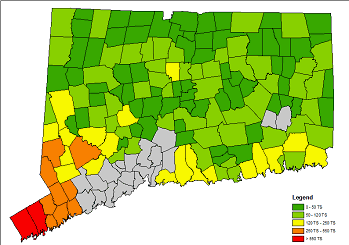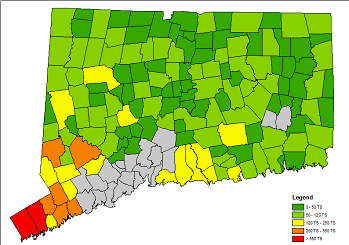BERLIN and STORRS, Conn. (April 29, 2014) – When Mother Nature brings destructive weather to Connecticut, it can cause significant damage to the state and its electric system. While Connecticut Light & Power tracks impending storms closely, it is difficult to predict where severe weather will hit the hardest and cause the most damage. Now, new damage prediction modeling developed by a team of UConn environmental engineers is able to provide CL&P customized information in advance of a storm to allow the company to better plan and prepare.
“With this new technology, we have critical guidance ahead of a storm about severity and where we may see the most significant damage to our electric system, which can help us determine where to pre-stage crews and equipment,” said Peter Clarke, Senior Vice President of Emergency Preparedness at Northeast Utilities, parent company of CL&P. “We're very fortunate to have a renowned institution like UConn right here in our backyard which can take complex challenges and offer real-world solutions that will benefit our customers during major storms and power outages.”
UConn and CL&P began working together in 2011 to develop a reliable storm prediction model. The technology brings together weather parameters such as wind speed forecasts from the National Weather Service, historic data in CL&P’s outage management system from various types of storms, and information from the company’s vegetation management programs to make its predictions. This new tool is already providing CL&P with estimates on the expected strength of impending storms, as well as estimates on the location and extent of any damage they may cause. While there is no way for a utility to prevent outages in the face of Mother Nature’s wrath, this new technology is just another tool CL&P can use to gather more information to improve emergency preparedness and response.
“Our hazardous weather forecasting capabilities at UConn are world class,” said UConn Provost Dr. Mun Y. Choi. “This partnership allows us to work together to help provide Connecticut residents greater peace of mind that utilities will be better-equipped to prepare and plan for the kind of damage that we see in New England during severe conditions.”
The UConn team continues to improve the accuracy of the predictive model by expanding possible storm scenarios and enhancing its ability to adjust as needed for future changes in vegetation management, climate, and electric system infrastructure conditions. While refining the tool based on information in Connecticut, Northeast Utilities is also planning to expand use of the model at its operating companies in Massachusetts and New Hampshire.
In addition, CL&P and UConn are working together to reduce the threat of tree-related damage to the electric system through STORMWISE, a forest vegetation management program. CL&P and UConn have teamed up with the Connecticut Agricultural Experiment Station to integrate tree education, management, and research to develop effective solutions to mitigate tree risk. Researchers find that trees with adequate space to grow are healthier and more resistant to high winds. They also encourage a “right tree, right place” approach -- which suggests that certain species of trees are better suited near power lines than others. The goal of STORMWISE is to develop recommendations that will help to make trees and forests in Connecticut more resilient during severe weather, while maintaining the beauty and character of the state’s roadside forest.


Fig. 1 (left) PREDICTED – Before Hurricane Sandy struck Connecticut on Oct. 29, 2012, UConn environmental engineers using new storm damage modeling technology predicted an estimated 13,330 trouble spots (TS) around the state where CL&P crews would be needed to restore power. This map shows the predicted outages. The gray areas represent towns served by other power companies. Image supplied by the University of Connecticut.
Fig. 2 (right) ACTUAL – This map shows the 14,338 actual power outages impacting Connecticut Light & Power customers in the wake of Hurricane Sandy. CL&P officials say the accuracy of UConn’s storm damage prediction technology will allow the company to better plan and prepare for major storms. Image supplied by the University of Connecticut.